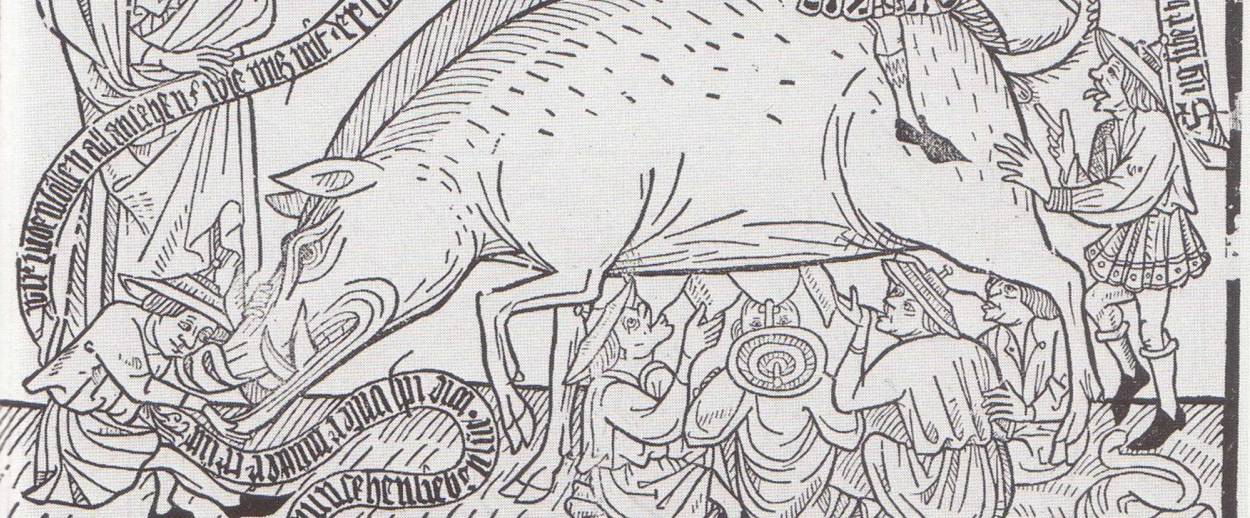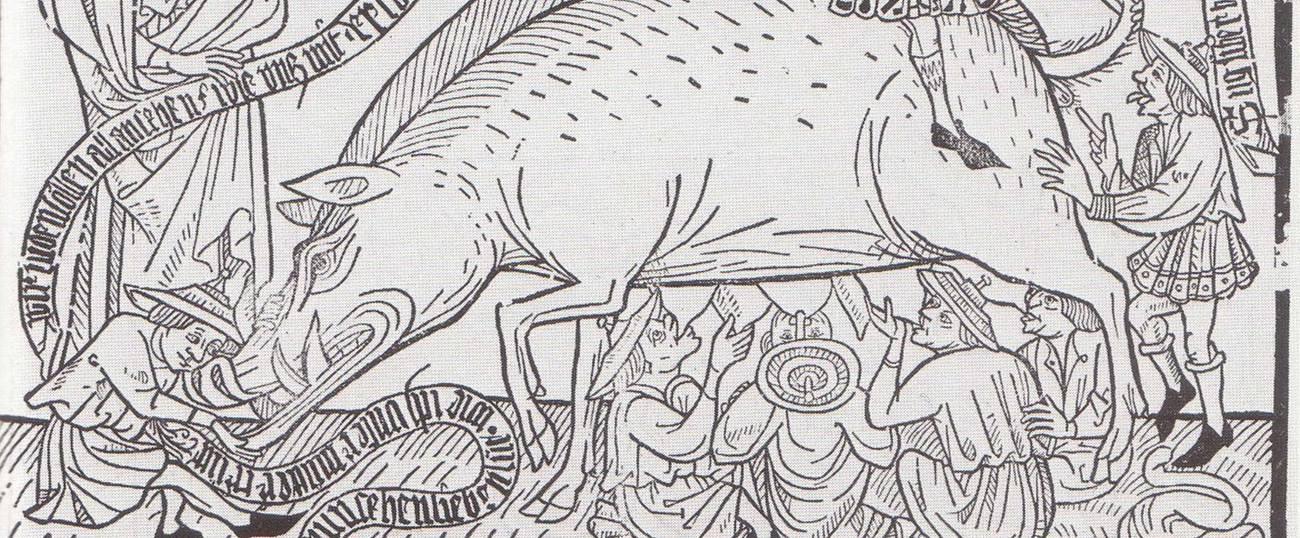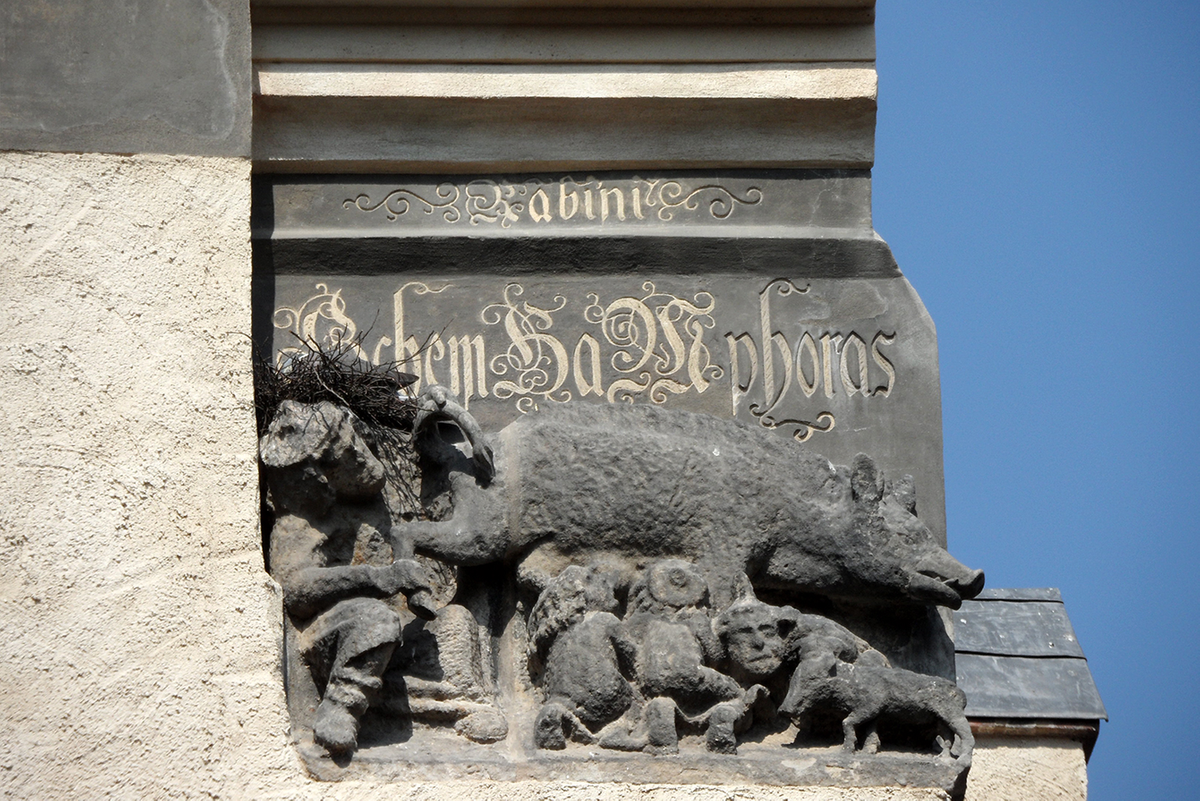Amid Celebrations of Martin Luther, Some Want to Talk About His Anti-Semitism
On the anniversary of the Reformation, we can’t forget what Luther thought about Jews




In Wittenberg, Germany, right now, walking around without a city map in one hand and camera in the other makes you stand out. The Protestant Reformation began, one could argue, 500 years ago this month, and tourists have been coming in droves to its birthplace. Martin Luther did not begin the Reformation but gave it a major kick in the pants here, and just about everything here is named after him, including the city’s official name, which in 1938 became Lutherstadt Wittenberg.
Outside the central train station, a billboard advertises the Luther-Hotel’s “Luther Burger and Käthe Nuggets”—Käthe for Katharina von Bora, Luther’s wife. Shops lining old town Wittenberg’s cobblestone streets sell cookie cutters shaped like Luther’s head and Playmobil’s special-edition Luther figurine. The city’s free public Wi-Fi network pays tribute, too: +LutherWLAN.
According to legend, on Oct. 31, 1517, Luther nailed a copy of his 95 Theses to the wooden doors of the Castle Church in Wittenberg. In his theses, Luther criticized the pope and Catholic Church practices like the selling of indulgences for redemption (when in reality, Luther wrote, the money was for renovations of St. Peter’s Basilica in Rome). The doors burned down in 1760, but because of the printing press’s advent, copies of Luther’s work went viral, and he helped splinter the Catholic Church.
But Luther wrote more than just the 95 Theses. He’s also the author of a corpus of virulent anti-Jewish writings. Over the next 30 years, as Protestantism took root, Luther evolved from being tolerant of Jews, hopeful they could become good Christians, to being disgusted with them. He described Jews as blasphemous, contaminators and murderers who should be expelled by Protestant authorities.
***
Helena Fuentes, a nun with the Evangelical Sisterhood of Mary in Darmstadt, near Frankfurt, wants people to acknowledge this dark side of Luther before celebrating the Reformation. On Wednesdays, she joins other members of the Sisterhood who stand by Wittenberg’s main square with Pastor Thomas Piehler of the Andreas Church in Leipzig. Together, they’ve been hosting silent vigils calling for an anti-Semitic stone relief on a historic Wittenberg church to come down.

The relief is called a Judensau, or Jewish sow, high up on an exterior wall of St. Mary’s Town Church, a UNESCO World Heritage Site where Luther preached.
“Praise of God and Jew hate do not belong together,” Piehler added. He and the nuns hold banners with statements, in German, like “Luther used the Judensau for his anti-Semitism” and “Let’s call it Luthersau. Then would you take it down?”
Luther wrote about this relief in 1543 in On the Schem Hamphoras. The title of his work refers to the nonsensical name of the Wittenberg relief, apparently a play on the Hebrew term shem ha-meforash, which refers to God’s name. Luther describes the rabbi as looking under the sow’s tail into the Talmud, insinuating that the ancient writings on Jewish law and tradition were in her bowels.
Earlier this year, the Wittenberg city council voted to keep the Judensau on the church, arguing that to do so preserves history. Piehler, though, hopes the attention paid to this Judensau could renew the debate. “So many articles have been published in Germany and this question has once again come to the table,” Piehler said. “That is very important to me—that the discussion does not stop there, and of course, our hope is that the Judensau is taken down in the Jubilee year.”
Historian Mirko Gutjahr, of the Luther Memorials Foundation, points out the downside of taking it down. Gutjahr is a curator of the Wittenberg exhibit “Luther 95 Treasures 95 People,” which includes pieces related to Luther’s anti-Judaism. If a museum displays the Judensau within its walls, only people “coming to the museum to learn things,” would see this stone relief, Gutjahr said. He doesn’t think that’s an effective way to combat anti-Semitism.
Instead, everyone should have access to the Judensau. It should stay exposed in the city “like an open wound,” Gutjahr said. But he, like Piehler, believes the topic, and Luther’s anti-Judaism more generally, should be debated. “Parts of the world are taking up ideas which we thought would be now in the backdrops of history again,” Gutjahr said, referring to current anti-immigrant sentiment—in medieval Germany, a Judensau was supposed to deter Jews from settling in an area. You should not leave it out, he believes, “since it’s part of the history as well, part of the Reformation and part of Martin Luther.”
Another question, still unresolved, is how much to blame Luther for Nazism, centuries later. Julius Streicher, who published some of the most hateful propaganda against Jews in his anti-Semitic newspaper, Der Stürmer, brought up Luther during his trial before the International Military Tribunal at Nuremberg.
“Dr. Martin Luther would very probably sit in my place in the defendants’ dock today if this book had been taken into consideration by the prosecution,” Streicher said in the morning session on April 29, 1946. “In the book The Jews and Their Lies, Dr. Martin Luther writes that the Jews are a serpent’s brood, and one should burn down their synagogues and destroy them…” Later that year, the tribunal convicted him of crimes against humanity, and he was hanged.
Others ask whether this is an anachronistic reading of history. Luther certainly was not the only one of his time to bash Jews. Plus, Luther also attacked Turks, Islam, and the papacy.
“This is precisely the opportunity to ask those kinds of questions,” said Dean Bell, professor of history at Spertus Institute for Jewish Learning and Leadership in Chicago, who’s been speaking at and attending recent events on Luther.
***
Luther didn’t start off writing so spitefully of Jews. In 1523 he wrote the essay “That Jesus Christ Was Born a Jew,” hopeful that Jews would see the ties between the Old Testament and Jesus’ doctrines, prompting them to convert. He lamented that Jews had been exposed to the wrong teachings.
About 20 years later, though, he had lost sympathy. “Even now they cannot give up their inane raving boast that they are the chosen people of God, after they have been dispersed and rejected for 1,500 years!” he wrote, in 1543, in The Jews and their Lies.
Luther didn’t have much actual contact with Jews. During his lifetime, Jews were restricted in where they could live and what jobs they could keep. They often worked as money lenders, since they could charge interest on loans, a practice forbidden to Christians at the time. He did meet some Jews who had converted, and he welcomed them into his fold.
In 2015, the German Protestant Church expressed official guilt over Luther’s Jew hate. “The horror at such historical and theological aberrations and the awareness of our share of guilt in the continued suffering of Jews give rise to a special responsibility to resist and oppose all forms of enmity and inhumanity towards Jews today,” it said, in a statement.
Still, some Germans remain in a kind of denial. In September, Gutjahr had a phone conversation with a woman who called him to say the Nazis must have written Luther’s anti-Jewish texts. “She couldn’t believe that this intelligent man was able to write those bad things,” he said. Although he tried for two hours to convince her that Luther wrote them, he failed. “This shows that people still hold up Martin Luther as an important figure and kind of hero, if you will. They try to conceive Luther only in a special light.”
On Oct. 31, though, the spotlight will be on Luther’s positive contributions. This is the first time Germany has made the Reformation anniversary a national public holiday, and Chancellor Angela Merkel is expected in Wittenberg that day. Piehler says that he and the nuns will also hold their banners on that day, and will continue their vigils through early November.
***
Like this article? Sign up for our Daily Digest to get Tablet Magazine’s new content in your inbox each morning.
Verónica Zaragovia is a freelance journalist based in Berlin. She originally moved to Germany on a fellowship with the Robert Bosch Foundation.